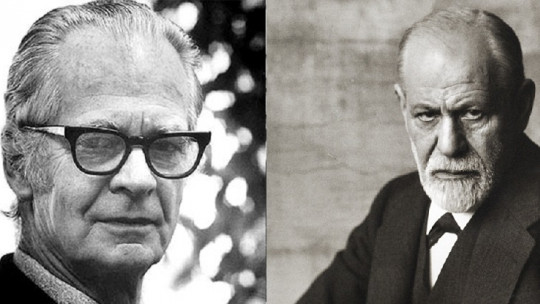
Defining what is meant by ontological behaviorism is not a simple task, given that it is a term that is used to understand some philosophical aspects of this way of understanding psychology.
Behaviorism, although it is not properly considered a philosophical current, like any psychological current, tries to describe how human beings act, resorting in a very limited way to aspects of philosophy.
Let’s look at some concepts discussed in ontological behaviorism through a simple explanation of this concept.
What is ontological behaviorism?
Trying to describe what ontological behaviorism is about, or trying to discern what the ontological foundations of the science of behavior are, understood in its strictest sense and without resorting to internal processes, is not an easy task.
The most radical and classic behaviorism, represented in the figure of John B. Watson and Skinner, argues the following:
1. Psychology is the science of behavior
The most classical behaviorism prefers to avoid entering into the dark and difficult to measure aspects of the mind, such as internal psychological processes that lead a person to act in one way or another or, basically, unobservable behavior.
Saying that psychology is the science of behavior implies, for the benefit of behaviorism, rejecting it as the science of the mind. What is sought is the external, the observable, what can purely describe the visible behavior of the individual.
2. Behavior must be described without resorting to mental processes
Behavior, understood from the behavioral perspective, must be measured in terms of external behaviors. The individual’s behavior must be described and explained without reference to mental events or internal processes.
The sources of behavior are external, that is, the factors that make an individual behave in a certain way come from the external environment, not from the internal environment, such as the mind.
3. On the development of psychological theories
If, during the development of a psychological theory, mental terms are used to describe or explain behavior, These terms should be eliminated, or replaced with more behavioral terms.
If replacement is not possible, the mentalistic terms should be described using behaviorist language.
About free will
In behaviorist ontology there is a very crude idea about the concept of free will, or freedom of choice. This freedom usually refers to the fact that the individual can choose, completely freely, his or her destiny. Thus, a person can choose the path of good or the path of evil, if a religious-spiritual perspective is taken of the concept of free will.
Many people, defenders of the concept of mind or soul, make a distinction between human freedom and animal conditioning, this being a criticism of the behaviorist model for extrapolating, in a too exaggerated way, the results obtained with animals to the human model.
The pro-mind/soul consider that human beings are capable of rising above their genetic and environmental characteristics, except in cases where there is serious psychopathology. Human beings are free to overcome epigenetic conditions and decide their own path completely voluntarily.
The behavior of an animal, such as a cat, a dog or any other, could not be due to a completely free decision, it could not fight against environmental and genetic conditions. For example, a cat that is playing with a mouse and then killing and eating it is not really acting freely. He is acting instinctively. Although, putting ourselves in the shoes of the poor mouse, we would say that the cat is acting evil, he is not really doing it that way, he is simply behaving as the world has conditioned him.
But what is defended from ontological behaviorism is that really, and from a perhaps too exaggerated perspective of behaviorism itself, the concept of good and evil cannot really be applied to human behavior because freedom of choice is, in reality, a mere illusion. There are no differences between a cat and a human being other than simple intellectual complexity.
An example
Let’s take the case of a robber. Socially, his criminal behavior will be considered something bad, a decision resulting from having chosen the path of evil. However, if we tried to look at his individual history and could know his genetic heritage, perhaps we would see that, really, the world, as it has done it, has forced him to act this way.
It is obvious that what he is committing is a crime and he must be punished for it, in addition to being given the necessary resources so that he can rehabilitate himself and be able to function in life without having to continue committing crimes. However, and putting ourselves in the shoes of the robber, is he really robbing because he likes it, because being able to decide between one path or another, he has decided to do evil?
From the outside we might think that there are enough resources in society so that a person does not end up committing crimes. However, perhaps having grown up in a dysfunctional environment with few resources, in addition to having a certain intellectual limitation, has forced him to follow the path of crime, losing hope in being able to act in a less socially disruptive way. The damage he has done should not necessarily be seen as synonymous with evil.
The concept of evil is a product of religion, a qualitative way of classifying human behavior. The most purist behaviorism chooses to describe behaviors in terms of stimulus-response, not giving them a value or trying to unravel the internal processes that have caused it to occur, since environmental factors are more important.
About thinking
For one of the most famous behaviorists, BF Skinner, thinking is nothing more than a series of silent whispers or at least that’s how he described it in his book Analysis of Verbal Behavior (“Verbal Behavior Analysis”). Human beings give verbal responses when we are asked questions, and we have “silent whispers,” that is, thoughts about that same behavior, behavior which constitutes the act of speech.
Our verbal behavior, when the time is appropriate, makes use of logical analysis, but this does not mean that the mind really has the capacity to act completely freely. When we think, the actions we have seen and the words that have been said to us really condition our mind. The mind would be nothing more than the effect of conditioning factors such as past experiences, what we have heard and all this mixed with the action of neurotransmitters and gene coding.
From ontological behaviorism, the human being, in terms of behavior, is no more free than the cat in the previous example or a properly programmed robot. He receives inputs and the supposedly free mind would act logically and consistently, preparing the most appropriate output for the occasion, no matter how free that decision seemed.
This way of conceiving the mind, thought and internal processes would be what would cause behaviorism to decline, after having been the most powerful current in the 1960s and 1970s, and cognitive visions take on a greater role.
TOAlthough cognitivism has used behavioral techniques, it has called for the need to know the individual’s purpose when carrying out a certain behavior, and look at all the internal processes that explain why a certain behavior occurs. Cognitivist psychologists do not accept behaviorism as a sufficient current since it rejects, at least its most radical aspect, the existence of the mind or that it should be an object of study.








